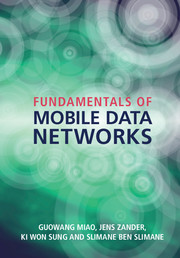Book contents
- Frontmatter
- Contents
- Preface
- Acronyms
- Notations
- 1 Introduction
- 2 Wireless network models
- 3 Medium access control
- 4 Scheduling
- 5 Principles of cellular systems
- 6 Transmitter power control
- 7 Interference management
- 8 Association and handover
- 9 Energy-efficient design
- 10 Long term evolution
- 11 Wireless infrastructure economics
- About the authors
- Index
- References
11 - Wireless infrastructure economics
Published online by Cambridge University Press: 05 March 2016
- Frontmatter
- Contents
- Preface
- Acronyms
- Notations
- 1 Introduction
- 2 Wireless network models
- 3 Medium access control
- 4 Scheduling
- 5 Principles of cellular systems
- 6 Transmitter power control
- 7 Interference management
- 8 Association and handover
- 9 Energy-efficient design
- 10 Long term evolution
- 11 Wireless infrastructure economics
- About the authors
- Index
- References
Summary
Communication infrastructures
Most of this book has covered how to provide effective wireless access services and the efficient utilization of the spectrum resources. In the previous chapters we have also looked at energy aspects. Now we will widen the scope even more as we look at the total resource consumption in a wireless access infrastructure. This will include networks, switches/routers and access ports and the terminals, as described in Chapters 2 and 9. In this chapter, the tradeoff between the resource consumption incurred by adding more access points, i.e. a more expensive infrastructure, and increased capacity and a higher QoS provided to the users, will be reviewed in more detail. We will make comparisons among such diverse quantities as frequency spectrum allocation, equipment, physical infrastructure including towers and antennas, real estate, power consumption, user equipment and maintenance. Such comparisons are naturally made in monetary or economic terms. The total cost of running a wireless access system comprises the cost of all these individual components. In economic terms, this is usually referred to as the supply side of operating a network. This cost of providing (supplying) the network has to be compared with revenues that the system provider, for example an operator, can derive from the users, i.e. what the users are willing to pay for the service. The “will” in turn is based on user demand and user satisfaction. Supply and demand are tightly coupled and together determine if operating the network will be a profitable endeavor, i.e. that the revenue will exceed the investment.
Although not always easy, it is usually possible to compute the cost of network operation, as we will see later in the chapter. However, understanding the demand and willingness to pay is difficult to model and will depend on how the services are provided and which actors are providing them. The telecommunications industry has been a global one for over a century, with many actors. Whereas previous chapters have outlined the supply chain of actual communication (transport) services, the picture has been more complicated in the past as the actual content transmitted and the services that have been provided by and through the network have been interwoven with the network service itself. Figure 11.1 gives a rough description of the actors on the scene and their interrelations.
- Type
- Chapter
- Information
- Fundamentals of Mobile Data Networks , pp. 282 - 298Publisher: Cambridge University PressPrint publication year: 2016



